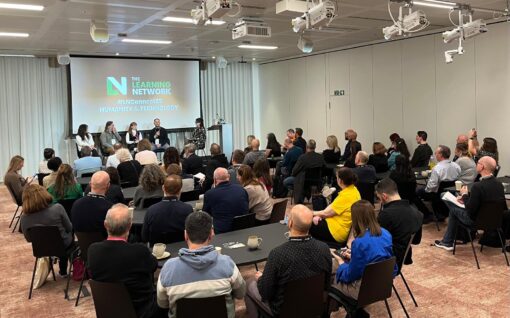World of Learning 2024: Getting beyond “more crap quicker” and into performance and productivity
Conference talks can go meta and granular in the blink of an eye. One minute you are listening to a summary of the state of productivity in the UK, the next you are listening to how AI can help managers get better at difficult conversations with team members.
My interest lies in trying to make sense of what all of this means for the learning industry and its direction of travel. And my interest also lies in finding out how learning professionals are helping their organisations improve organisational performance. At this year’s World of Learning conference, I was also acutely aware of what I consider to be the limitations of the current conference format, one of which is the lack of space for focused discussions on technology. Technology is a big driver of change in learning (genAI, anyone?) and yet there is no space to talk about how that technology is transforming the various stages in the learning cycle apart from vendors selling their wares in the ‘exhibition’ space. More on this topic in another post.
In this year’s World of Learning Conference the opening keynote set out the meta challenge facing organisations in the UK – flatlining, low levels of productivity – and the rest of the conference sessions explored how learning teams can play their part in helping organisations become more productive.
The productivity challenge
Opening keynote speaker, journalist Robert Peston, explained that UK productivity is significantly lower than countries such as the US, Germany, and France, which leads to lower living standards. The 2008 financial crisis halted productivity growth, and since then the UK has struggled with flatlining productivity and investment.
“Our productivity has been lower than our main competitors for decades… it’s about a third lower than in the US, it’s about a third lower than in Germany and much of Scandinavia, and it’s about a fifth lower than in France,” he told delegates. “Since 2008, we’ve had this extraordinary period of lacklustre growth… flatlining productivity and living standards.”
Peston highlighted the gap between the UK’s top-performing businesses and a long tail of underperforming ones. A major issue is inadequate management and workforce skills. He said that UK businesses often lack the ability to make the most of technological investments compared to their US counterparts, due to weaker management skills.
“There is definitely something we need to do at that [management] level… the boss class isn’t good enough. One of the things that has been compelling is that UK businesses don’t make as much of their investments… research shows that the way investments are implemented by the people at the top is the key factor.”
This link was made clearly through data shared by Kerri O’ Neill, chief people officer at Ipsos UK and Ghassan Karina, founder and CEO at Ipsos Karian and Box. Their research shows that 25% of UK workers neither understand nor believe in their employer’s strategy. And absence rates in organisations that exhibit low psychological safety are more than double (4.2%) than those in organisations where it is in evidence (1.9%).
The research also shows that highly engaged, high-performing teams are 27% more likely to stay with an organisation, 38% more likely to have higher levels of motivation at work and 42% more likely to advocate for their employers.
According to Ipsos, the seven traits of high-performing teams are:
- Active listening and openness to giving and receiving feedback
- Clarity of team mission and alignment
- Empowering behaviour and two-way trust
- High psychological safety and willingness to experiment
- Obsessive about meeting customer needs
- Proactive manager coaching and challenge
- Team resilience and agility
Organisations that listen to their workers and empower them to make decisions see an increase in ideas generated from employees and faster decision-making. Both are important elements in helping an organisation become more agile.
The good news for learning teams is that, according to Ipsos research, 74% of workers want to learn new skills to keep up with advances in their industry. However, only 54% say they have been given sufficient opportunities to grow and develop at work.
Learning design
So how should L&D teams approach learning design now that genAI is here?
Nick Shackleton -Jones, founder of Shackleton Consulting, urged L&D teams to focus on the human elements of learning and how we learn, rather than using genAI to create more content. “The vast majority of AI stuff has nothing to do with learning. It’s content pushing… it’s more crap quicker.”
He says AI can be most useful in performance support by offering guidance on tasks and skills in real time, rather than mimicking traditional education methods like digital lectures. “Just converting a document into a video lecture doesn’t make it more useful.”
Nick Welch, digital learning manager at Heathrow, shared some of the ways his team is designing learning experiences using AI. He showed a resource for new leaders that was created using AI generated images, which have dramatically reduced the production time and costs, as well as a coaching application to help managers have difficult conversations with members of their team. He showed an avatar that can be used in meetings to share specific knowledge and expertise that might be needed during customer calls. Welch also said that AI ‘buddies’ could be really useful for new starters as making friends when you start a role in a new organisation can enhance the onboarding experience.
For all the potential benefits of using genAI in learning, Shackleton-Jones highlighted the problem of AI absorbing people’s skills and capabilities. He used the example of Google Maps – now that we use Google Maps, we no longer need to be able to read a map. “AI will enable people to perform more, but it will absorb their capability… to the point where the organisation is more and more reliant on AI.”
Learning communities
Another more human approach to effective learning is building social learning communities.
According to Andy Lancaster, chief people officer and consultant at Reimagine People Development, “Communities are one of the most cost-effective ways of developing people and one of the most energising ways for people to engage with development.”
Lancaster outlined the ways in which communities can support learning, including:
- sharing information across organisations
- spearheading and showcasing good practice
- problem solving through bringing together diverse thinkers
- seeding innovation – communities foster innovation
- supercharging development by allowing people to bring their own needs and contexts into learning rather than following rigid programmes
- psychological safety, which is key for communities to thrive. It allows members to share ideas, ask questions, and challenge each other without fear of judgement, which fosters more effective teamwork and innovation.
- human connection – communities provide a space for personal connection, which can enhance creativity, productivity, and well-being in organisations.
And Helen Marshall, chief learning officer at Thrive, brought this to life by describing how she created and grew the Womenin community. Marshall said the community was born out of a lack of opportunity for women to share and to understand what best practice in learning looked like outside of the walls of their own organisations, and to also help women who were returning to work after a break. Realising that many women struggled to find the information they needed, in December 2022, Marshall set up a WhatsApp group with the aim of connecting women from across the industry so that they could connect and share with others.
Marshall says that communities can be an effective way to help solve problems. “Pretty much overnight we ended up with over 100 members. I thought, well this is resonating with people, I have honed in on a problem here that people want to solve.”
“So from that moment, it continued to snowball. And I think what’s really important to point out is that, from the get go, the idea was that we were creating a safe space in which people could share and be a little bit vulnerable because those people returning from maternity leave felt very vulnerable, they didn’t feel like they were up to speed. And they didn’t feel like they had the knowledge that they needed, even though, in most instances, they did. It was that reassurance and ability to ask for help when they needed it which was so important.”
Coming back to the central challenge laid out by Peston – how can UK employers increase performance and productivity?
Clearly AI will have a big role here and many conference speakers shared how it is being used and developed to transform the learning experience. And this development of AI will, and is already, having big implications for the role of humans.
Peston and others point out that humans will need to focus on the skills that AI does not have – interpersonal skills etc – as well as developing the skills to use AI in roles as they evolve. But there remains an elephant in the room and that is organisations’ understanding of what human behaviours drive performance. The Ipsos research is unambiguous – managers that listen, support their teams to learn, share and enable them to work autonomously in a trusted, safe environment are seeing increased performance.
Until organisations understand and tackle this challenge – and L&D has a role in educating senior teams here – there won’t be the strategic understanding of performance needed to frame how organisations can develop and benefit from both human and technological capability and how organisations and workers can benefit from the productivity gains.
As Peston said, we need to support workers as we evolve work with AI. “I massively believe in the potential of AI to improve our productivity… but we have to support people whose jobs are displaced by AI and ensure that those whose jobs are augmented by AI are rewarded for it.”

